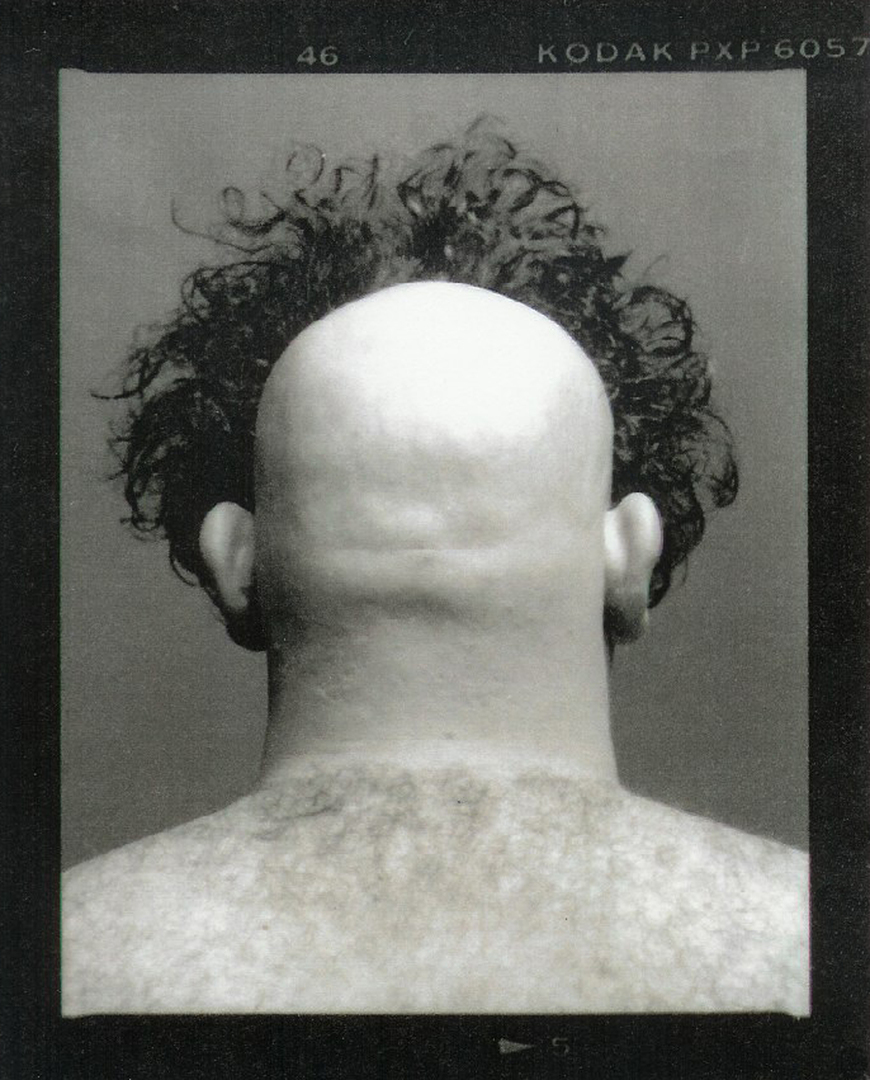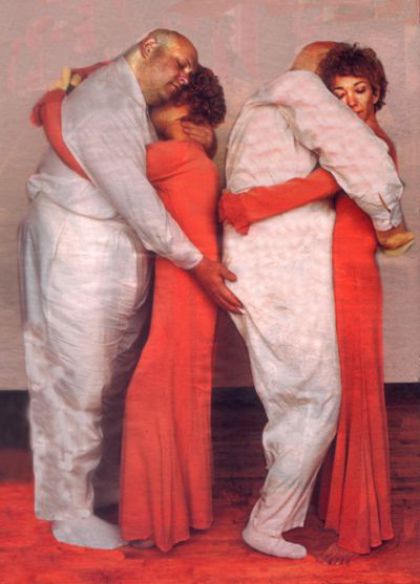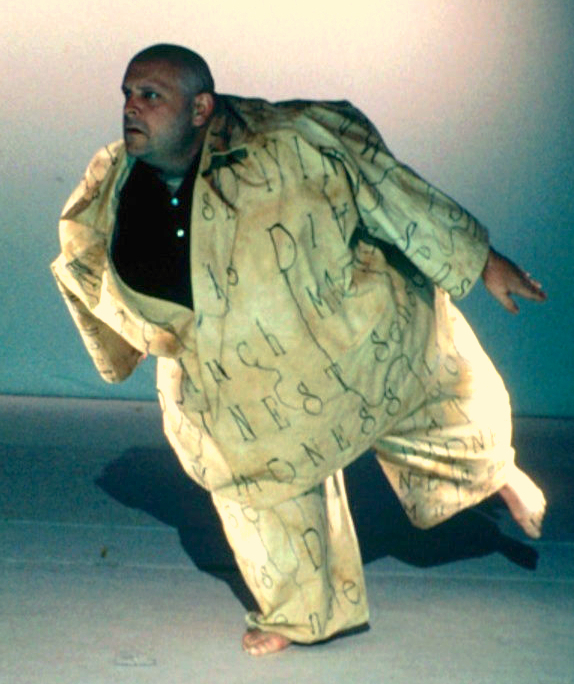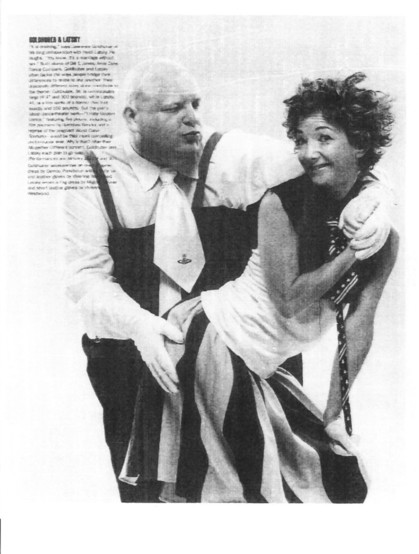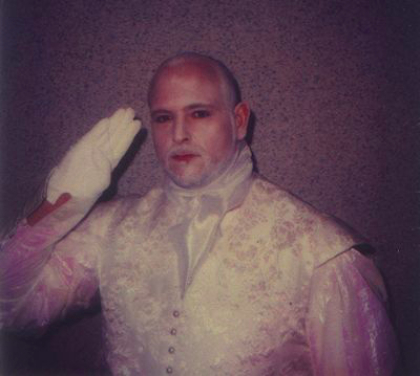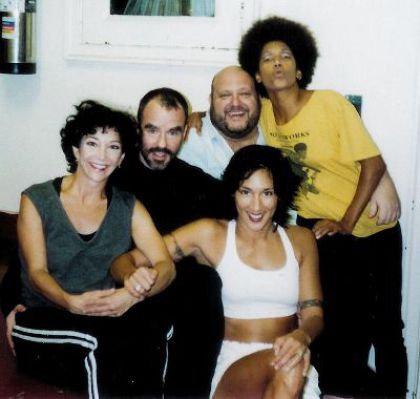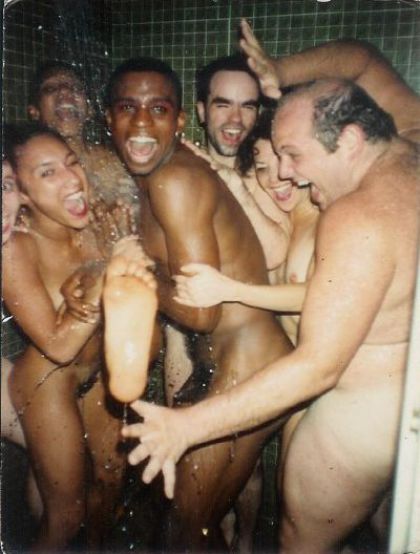CONTACT: GOLDHUBER@GOLDHUBER.COM
LOOKING BACK FURTHER.....
GOLDHUBER & LATSKY
1993-2000
JUST THE TWO OF US from I HATE MODERN DANCE
PHOTO: COVER OF NOW MAGAZINE, TORONTO
NEW YORK TIMES DANCE REVIEW
The Tall and Short Of a Shifting Relationship
By ANNA KISSELGOFF
The human comedy in its broad sense is of concern to Heidi Latsky and Lawrence Goldhuber, whose wit and acuity were evident in the works they presented on Thursday night.
Formerly leading dancers in the Bill T. Jones/Arnie Zane Dance Company, they are now choreographers to watch in the future. Their creative springboard is a difference in height and weight. Ms.
Latsky, a natural virtuoso, is 5 feet tall and weighs 100 pounds. Mr. Goldhuber, a quicksilver mover who can look sinister or lovable, is 6 feet tall and is said to weigh 300 pounds.
This contrast in physique became a metaphor for the ups and downs in evolving relationships: the program, entitled ''Do We Dare'' consisted of the New York premiere of ''It's Not What You Think'' and
the new ''Too Much, Too Little, Too Bad!''
Commissioned by the American Dance Festival in Durham, N.C., where it will have its official premiere on July 1, ''Too Much'' shows the choreographers going beyond their Mutt-and-Jeff idea and
exploring characterization with more depth. There is pain as well as humor in the two ruling images. Ms. Latsky starts off in a straitjacket of a dress, with stretched sleeves attached to the
ceiling. As she turns or leaps, her body is tied up in knots. Robert Wierzel's emotional lighting captures Mr. Goldhuber in another spotlight. He sits in Liz Prince's padded birthday suit, a blob of
bulbous flesh.
Each dancer is thus physically limited. Ms. Latsky's dynamism, expressed in quick footwork and mobile torso, is hemmed in. Mr. Goldhuber is all mock flesh, painfully so as he heaves his padded
abdomen around or staggers about.
Deliverance comes to Ms. Latsky as her dress flies overhead and Mr. Goldhuber sheds his bodysuit. That both will again be encased in these costumes emphasizes the freedom their characters find as
their inner selves. Between them stands a table with a real turkey that they carve and stuff into each other's mouths. With freedom comes temptation.
Somehow, all the precisely choreographed mayhem sits superbly with the music, Brahms's Sonata for Cello and Piano, No. 3. The same is true of Mozart's Violin Concerto, No. 5 in ''It's Not What You
Think.'' Here, the duo is more obvious, playing with body type to express tender or combative moments. April 14, 1997
WORST CASE SCENARIO
NEW YORK TIMES DANCE REVIEW
Subverting Hatred With Quiet Luminosity
By JENNIFER DUNNING
Lawrence Goldhuber and Heidi Latsky describe their new ''Worst Case Scenario'' as an exploration of the role that hatred plays in people's lives. Violence threads through the hourlong piece, most
powerfully in combative partnering, angry solo dancing and photographic imagery of seeming hate messages printed on parts of the body. But the effect of the dance, presented by Goldhuber and Latsky
on Friday night at Performance Space 122, is far more visual than visceral.
In this collaboration with Lesley Dill, a sculptor, photographer and performance artist who works with language, Mr. Goldhuber and Ms. Latsky have created a luminous world of movable scrims and
gleaming white surfaces whose corridors and open spaces they scrawl through like emblems of disorder.
At one point Mr. Goldhuber, who is big, moves with uncharacteristic clumsiness in an even bigger padded beige suit imprinted with an aphorism about madness and divinity. A spectacled Ms. Dill,
looking like a slightly absent-minded urban wood nymph, pulls off the top of Ms. Latsky's dress and prints on her back and then licks to a smudge the words ''I hate your soul.'' ''Worst Case
Scenario'' ends with the tiny Ms. Latsky enveloped in an ornate beige dress from which Mr. Goldhuber and Ms. Dill methodically pull long ribbons of words.
''Worst Case Scenario'' is a feast for the eyes. As always, this irresistible pair offers quiet revelations about the nature of movement and of partnering and weight in dance. Underlying themes of
anger and hatred mainly provide continuity to these small dances, set to instrumental and vocal music by John Oswald, Joe Jackson and others.
Ms. Dill designed the stylish, imaginative costumes and projected images, with Annie Murdock. The subtle lighting was by Robert Wierzel. Douglas Rosenberg designed the production and video montage.
April 26, 1999
CLICK PIC BELOW TO WATCH GRETCHEN BENDER'S FILM OF
THE HEAD DUET
NEW YORK TIMES DANCE REVIEW
SENSUAL DUET FOR TWO HEADS
BY JENNIFER DUNNING
He is huge. She is tiny. But Goldhuber and Latsky are no longer a one-joke duo. With "I Hate Modern Dance," a suite of five full and excerpted pieces presented on
Tuesday night at the Joyce Theater in the Altogether Different festival, Lawrence Goldhuber and Heidi Latsky have created a charming, funny and thought-provoking look at dance and friendship. Mr.
Goldhuber weighs 300 pounds and is bald, with a Jack Bennyish slow, sly take on the world around him. Ms. Latsky weighs 100 pounds, has a crop of curls and moves like a hungry mosquito. But there are
more complex subthemes.
Mr. Goldhuber and Ms. Latsky appear to be dear friends subtly drawn to each other physically. There is also a seeming element of danger. Will he have a heart attack? Will she be crushed? And their
choreography offers an unusual perspective on traditional partnering.
The ways they dance together are set forth in the first two pieces, "Intro," to Mozart, and "I," to Brahms performed live by Michael Grigsby and Chris Lancaster. The vocabulary is simple. The
relationship is not. They might be a comfortably long-married couple. But Ms. Latsky's grittily successful self-determination in the face of Mr. Goldhuber's immense, stolid power says much about
traditional differences between men and women.
Two chilling solos are at the heart of "Hate," danced to music by John Oswald, Marty Beller and Andrew Poppy. Each dancer is trapped by confining costume elements but continues to move the same way
once those elements are shed. Mr. Goldhuber's solo might have been choreographed by Beckett. The dancers' interest in design is suggested in "Modern," a new black-and-white film by Gretchen Bender to
music by Joe Jackson, that stylishly depicts a duet for two heads as sensual as conventionally erotic body parts.
"Dance" brings the evening to an end on a tender, funny note with ballroom sequences set to popular scores and music by Vernon Reid. Nothing is quite as it seems throughout the evening. Here Mr.
Goldhuber and Ms. Latsky are joined by puppet doubles that enable them to address everything from impossibly high-flying lifts to everyday love affairs.
Robert Wierzel designed the lighting. The program will be repeated on Saturday night and Sunday afternoon at the Joyce (175 Eighth Avenue, at 19th Street in Chelsea). January 27,
2000
SHOW BUISNESS DANCE REVIEW
Goldhuber and Latsky
The Joyce Theater The Altogether Different Series 2000
by Victoria Yoffe
Opposites not only attract but come together in complete harmony when Goldhuber and Latsky take the stage. The oddly matched duo, completely opposing in height and
weight, achieve a perfect balance between theater and dance, able to entertain while maintaining a depth to their work that addresses identity questions and insecurities.
The title of the first work, It’s not what you think (part 1), epitomizes the success of the quirky yet powerful performances of Goldhuber and Latsky during their evening length work, I Hate Modern
Dance. The piece introduces the pair as individual performers dealing with opposing stereotypes as dancers and performers. The work plays on the idea of contrast starting in the beginning of the work
with Goldhuber and Latsky’s stillness while Mozart’s lyrical and powerful A Major Violin Concerto plays loudly in the background. Goldhuber often supports Latsky as her petite body jumps onto and
perches off his body as well as picks up Latsky haphazardly, swinging her through the air as if a she were a doll, creating something close to a human windmill. Their movement, ranging from unusual
lifts to dragging each other by the feet across the stage produced laughter and smiles from the audience while highlighting the true similarity found in difference.
In Too Much Too Little (part I) the focal point of the piece is the insecurities regarding the physical characteristics of the performers. Goldhuber appears in a costume that nearly doubles his size
while Latsky stands on stage confined by her arms stretched to the ceiling by flesh toned fabric. Performing movement from a ballet vocabulary, Latsky comments on the body types society expects from
a particular style and range of movement. While Latsky’s commentary comes from her movement, Goldhuber’s commentary comes from his lack of movement.
The commentary comes to a conclusion in the final piece Just the Two of Us, when mannequins resembling the performers dance with Goldhuber and Latsky, forcing them to look at and accept themselves as
performers. While light hearted and clever, the work stresses that people accept themselves rather than judge themselves on the opinions and ideas of the general public.
Goldhuber and Latsky bring a new type of performance to the stage. While neither pure dance nor pure theater the merging of the two art forms creates a new and refreshing performance style that asks
the audience to leave their stereotypes at the door.
DANCENOW 2015 GOLDHUBER & LATSKY REUNITE FOR HEAD DUET
===============================================================================================
BILL T. JONES/ ARNIE ZANE DANCE COMPANY
1985-1995
THE YEAR IN THE ARTS/ DANCE 1994
ANNA KISSELGOFF
A Death Recalled -- Lawrence Goldhuber's soliloquy, simultaneously danced and spoken, as he recalled his mother's death, was one of the strongest images in "Still/Here" in which Bill T. Jones visibly poured the rawest of human emotion into a strictly defined artistic mold. The work offered a stunning mixed-media lesson in how to formalize dance and speech without losing impact and honesty.
Bill T. Jones/Arnie Zane & Co.
LIFE STREAMS
by Laura Molzahn
Bill T. Jones has a quicksilver sensibility: it darts, elusive and vital. Watching his dances is exhilarating, but describing them is like trying to track the motions of
a swift fish in sun dappled, running waters. Transitions are quick and fluid; it’s difficult to say what makes them right. And though images may be repeated and so produce a firm impression, the
images themselves are full of mystery.
Bill T. Jones/ Arnie Zane & Co. brought to a brilliant close the Dance Center’s series on the African American tradition in modern dance. Jones is black, but there’s not much that’s overtly
African American in his dances. Like the works of other groups who appeared in the series, they are just unquenchably alive.
Zane, who died of AIDS in 1988, was white. His work was represented on this program by The Gift/No God Logic (1987), the last dance he choreographed. It is austere, dry, very quiet and
measured. Some of it is performed to arias from Verdi’s La Forza del Destino, but much of it-and all of the last section- is performed in silence. This highly formal quartet makes eloquent
use of the stage space with simple patterns, simple poses and gestures, and unusual partnering. Jones’ Forsythia (1989) also on this program, seems to take some of it’s almost
idiosyncratically personal, performed mostly in silence or to Zane’s recorded readings of texts describing two dreams.
Jones’ D-Man in the Waters was the evening’s clear standout. Dedicated to Demian Acquevella, a member of the company who’s ill, this full company work is serious but never despairing- it’s
filled with a sense of struggle that’s triumphant in part just because it goes on and on. Because the work has an unstoppable momentum, despite some quiet sections, Jones’ choice of Mendelssohn’s
Octet in E-flat seems inspired: the strings’ rich sounds are lyrical and singing, even when the music rushes full force. As you listen, you see the eddies and ripples and hear the chattering sounds
of a small stream.
A swimming motif dominates the work: dancers use their arms to "breaststroke" across the space, or dive across the floor like waves of maddened belly floppers. Or dancers leap and cavort over others
rolling along the floor, as if they were ocean bathers, challenged by breakers. Bent arms rippling wavelike before the chest reiterate the music’s swift rhythms; a simple high stepping on half-toe,
head down, does the same for a slower section. Often the arms are used like semaphores or stuck out to the side like a kid’s imitation of an airplane, and rapidly vibrated. Hands are held flat before
the face and swiftly twiddled-it’s like a ballet dancer’s beats but for the hands. Dancers often pair up, lock legs, and move across the floor like wrestlers in a particularly combative intimate
tango.
Such things carry the dance kinesthetically, but D-Man in the Waters also has a certain emotional logic and structure. Part of that is contributed by the music, which moves from a sparkling
lively opening through a quieter section and ends with verve. But much of the work’s emotion comes from the presence-or absence-of a single dancer.
You can’t believe Lawrence Goldhuber is a dancer when you first see him onstage. He’s fat and balding and has a schlumpy look that makes it seem far more likely that he’ll break into a
comedians patter than into dance. But dance he does, with a remarkable poise, buoyancy, and musical power. Watching him perform is the sheerest fun-when he went off-stage now and again during the
first section, I found myself hoping he wouldn’t play only a cameo role. And Jones uses him with a madman’s prescience. Sometimes Goldhuber’s great height and bulk are employed straightforwardly, as
when he stands at the center of a quartet of dancers who adopt still poses. One by one each of the four topples in a different pose and is caught by Goldhuber, who receives each of them effortlessly
but carefully, as if rescuing statues from shattering were his life’s work. When he topples, all four of them catch him. At other times, Jones choreographs against Goldhuber’s type:
Goldhuber takes his turn, for instance, at moving swiftly across the floor with a partner and twirling gracefully beneath that dancer’s arm.
But Goldhuber plays a role in the dance that goes beyond mere entertainment. Because he’s literally a pillar of strength, his disappearance in the middle section seems a loss: Where is he? I worried.
Will he come back? Only at that section’s end does he reappear, and then it’s somberly, grandly. The other dancers’ attitudes of obeisance and awe almost seem to make him a deity. In the last section
Goldhuber partners Jones-who is himself tall and muscular-in the most remarkable way, tossing him as if he were a featherweight ballerina. Their dancing together is not balletic, however, but
raucous: Goldhuber hauls Jones around, and at one point, the two even have a violent rear-end collision.
I don’t mean to give Goldhuber’s part in D-Man in the Waters too much emphasis. for much of the dance he’s just one of the ensemble, only a bit more noticeable. And sections of the dance in
which he does not appear obviously have emotional force. Particularly moving is the sequence in which a male dancer carries a tiny woman (Heidi Latsky) like a board and deposits her in the arms of
another woman dancer, and Latsky wraps her arms around the woman’s neck and her legs around the woman’s waist with a vehement possession. Yet it’s done so formally, almost stiffly and
ritualistically, that any trace of sentimentality is scoured away. Arthur Aviles also plays a resonant role in the dance: short, heavily muscled, with a shaved head, he’s both grotesque and
beautifully mercurial. When he was tossed into the air like a joyful dolphin and the end of D-Man in the Waters, the image was so compelling it brought the audience to it’s feet.
But it’s Goldhuber you latch on to, Goldhuber you remember. Somehow his solid presence is at the core of this bewitchingly swift, whirling, elusive dance. That he’s so remarkably part of it, and yet
not part of it, is a testament to the nimbleness of Jones’s wit and intelligence.
OPERA NOW MAGAZINE from BBC VERSION OF NEW YEAR


